Sumida
Pottery
By Mike McLeodChances are, you have encountered Sumida pottery during a
treasure hunt. But because it is found in a wide variety of shapes and forms and called by
many names, you may not have immediately recognized this exquisite export pottery from
Japan.
Sumida is not typical Japanese pottery. In
fact, it is almost diametrically opposed to traditional Japanese tastes of minimalism and
delicacy. And for good reason. Sumida was created specifically to be sold outside the Land
of the Rising Sun. Not long after Commodore Matthew Perry forced the opening of Japan to
trade in 1853, Oriental collectibles became the rage of the Victorian world. A proper
Victorian home had an Oriental room or parlor, or at least a corner of a room, displaying
ceramics, fine china, Oriental screens, ivory and other such knick-knacks. Sumida pottery
would often be found there.
Sumida pottery is characteristically heavy,
and usually, it has applied three-dimensional figures. Other characteristics of Sumida as
defined in the excellent book by Herbert Karp and Gardner Pond, Sumidaaccording to us,
include: "The most common are (Sumida) items whose upper half (or less) is partially
glazed with a flambé glaze or glazed with two or more colors in a splashed application.
Often, the glaze has run, creating curtains or droplets. The unglazed portion of the body
is painted." However, some pieces are entirely glazed while others are bisque.
The applied figures range from plants
(flowers, trees, bamboo) and animals (elephants, dragons, tigers, deer, lions, bears,
foxes, wolves and more) to landscapes (caves-yes, caves represented by holes, sometimes
for handles, other times just holes-homes, mountains, lakes, and especially rock
formations like ledges, boulders, steep hillsides, etc.). Also, a wide range of humans are
often depicted-peasants, martial artists, women in kimonos, pilgrims, government
officials, rakan (Buddhist disciples, ascetics), children and more. However, the animal
most often seen is the monkey.
Many scenes on Sumida pottery depict fables
from Japanese folklore. The monkey is a common figure in many of those fables because of
their human-like actions of caring for the young, stealing and interacting with one
another in a community. Indeed, one magnificent example by Inoue Ryosai in the Lightner
Museum in St. Augustine, Fla., has 354 applied monkey figures swarming over homes in a
village. Another fabulous piece by Ishiguro Koko stands 48 inches high and exhibits 500
rakan. In 1899, it won first prize in an exhibition in Tokyo, and it now resides in the
George Walter Vincent Smith Art Museum in Springfield, Mass.
The intricacy of the applied figures is
often amazing. In the earlier works, individual features on faces can be seen in detail.
Eyes, lips, teeth and even tongues have been fashioned. Later on, perhaps when demand
required mass or faster production, the features were often drawn, with only a line for
the mouth, for instance
How the potters could create these
"works of art" in a great variety of styles and substantial quantities is beyond
me. The time and effort invested in many pieces would seem to make the cost prohibitive,
especially when you consider that each piece changed hands through distributors at least
twice, if not several times, before making it to the final buyer.
Even more astounding is the great breadth
of the work. Sumida pottery can be found as vases (in a gigantic range of styles and
shapes), bowls (with and without pedestals), pots, jardinieres, jars (with and without
lids), footed containers, baskets, incense burners, teapots and tea services, coffee and
chocolate pots and cups, saki pots, pitchers, jugs, smoking sets, humidors and tobacco
jars, ashtrays (some with match strikes), ships of good fortune, figures (Buddha,
fishermen, warriors, wrestlers, religious and political figures, etc.), tankards, mugs
(with one, two or three handles), inkwells, hanging vessels, lamp bases, chamber light
candle holders, table ornaments, hair receivers, chopsticks holders, and more.
Sumida pottery has often been called by
many names-Poo ware, Sumidagawa, Banko, or Asakusa Banko. Sumida acquired its name from
the Sumida River that runs through the Asakusa district of Tokyo. It was near the banks of
this river where it was first made. The Japanese word for river is gawa, hence the name
Sumidagawa. Sumidagawa is a softer, raku pottery created in the early 1800s. Poo ware was
the product of a Shekwan potter, Poo You-she, whose patterns were similar to those of
Sumida. "Banko" was the general term given to the Japanese export or souvenir
ware sold in Tokyo.
But whatever you hear it called, once you
gain an eye for Sumida, you will also gain a great respect for the potters who created it.
Although there were several potters who fashioned Sumida, the three most prominent were
Hara Gozan, Ishiguro Koko, and Inoue Ryosai. Their marks are inscribed in kanjis, or
modified Chinese character symbols. The marks can be found on the base or side of the
pottery or on a white tile affixed to the piece. Kanjis are often difficult for non-Asians
to decipher. Fortunately, many of the different marks used by each of the potters are
included in Sumida...according to us. However, not all pieces are marked.
Sumida pottery enjoyed its heyday between
the late 1800s and the 1920s. It was still produced until World War II and briefly after
the war. Pieces can be found that are marked "Nippon," "Made in
Japan," and "Foreign." In 1890, the McKinley Act required foreign goods to
be so marked. The ware was then marked Nippon.
In 1921, the government required all
products to be marked in English, so "Made in Japan" appeared. Those words were
also printed on paper and attached, but paper marks are rarely found these days. Co-author
Herbert Karp has found only one in his many years of collecting. It was affixed to a lamp
base, and for many years it had been hidden by a wooden stand at the bottom of the lamp,
which actually protected the paper mark from fading and wear.
Sumida pieces marked "Foreign"
were exported to England.
After Sumida fell from popularity, people
packed them away, threw them away or got rid of them. This is one reason why Sumida turns
up in out-of-the-way antique shops.
"If you look for it, you'll find
it," said Karp.
A variety of pieces can be found on eBay,
enough so that it has its own site. But because Sumida is fairly rare and not well known,
much misinformation is given about it. Fakes are few, but they do exist. Karp cautioned
that collectors should research a piece before bidding on it. Beware of descriptions
(particularly on eBay) that use the words Sumida-like. A prevalent problem is pottery
being presented as Sumida that is not.
Sumida is still somewhat obscure, yet it is
valuable. Smaller, more common pieces sell for a few hundred dollars and higher. Larger
examples, usually 15 inches and taller, are valued in the thousands of dollars, depending
on the piece. Some of the more intricate pieces command prices above six thousand dollars.
As I said, you've probably seen Sumida in
the past. Now when you do, you will have a greater understanding and appreciation for this
obscure and ornate Japanese
export pottery.

|
| Sumida on the
cover |
| (clockwise) |
| Mothers, maids, children - 24
figures surround 19-in. vase, Ishiguro Koko, $4,500-$6000. |
| 17-in. handle vase with
monkeys looking up at airplane inside top of handle; pilot is a monkey; Ryosai,
$3,500-$4,500 |
| Ten 7-in. tall figures on 4 x
15 in. bowl, $1,450-$1,950. |
|
|
All
Photos courtesy Herbert Karp and Gardner Pond, unless otherwise noted.
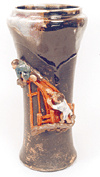
12-in. vase, 2 boys
on a bridge, Ryosai, $550-$800.
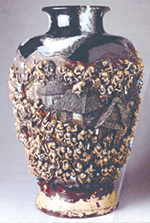
Magnificent vase
with 354 monkeys swarming a village; Inoue Rosai, 29 inches tall.
(Photo courtesy, Lightner Museum, St. Augustine, Fla.)

Teapots by Ryosai
(l., $450-$550) and Koko (r., $550-$800),
about 4 inches.
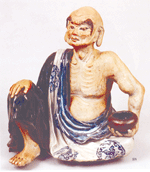
Rakan figure
(Buddhist disciple), identified by the long ear lobes and eyebrows, exposed chest, and
emaciation from asceticism; Hara Gozan, 11 1/2 inches, $3,500-$4,500.
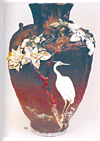
20-in. vase, crane
and flowers, Koko, $4,000-$5,000.
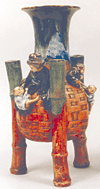
Woven-finished body
and bamboo-finish legs vase, lady with 3 children; by Gozan, $800-$1,050.
| SUMIDA...according to us by
Herbert Karp and Gardner Pond (192 pages and 700 photos, ISBN # 1-57080-085-5)) can be
purchased directly from the publisher, Antique Publications, by calling 800-238-7404 or by
visiting the website www.sumidaware.com. The hardcover version is $59.95, plus S&H, and
the paperback edition is $44.95, plus S&H. (S&H is $7.95 for the first book and
50¢ for each additional book.) |
|